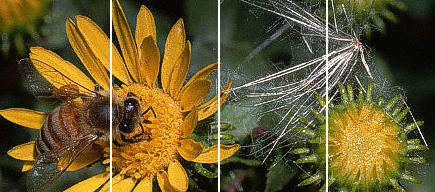 |
 |
» TARASSACO HONEY (Taraxacum officinale)
Produced in early spring only when the colonies of honey bees are sufficiently developed at the time of this flowering. Lombardy and Piedmont represent typical production areas.
Colour: bright yellow or beige cream, if mixed with willow honey.
Crystallisation: very fast and generally with very fine crystals.
Fragrance: very intense, almost ammonia, cellar, honeycomb.
Taste: similar to the fragrance.
Therapeutic properties: diuretic, depurative.
Usage: as table honey for anyone who appreciates the taste. |
» LIME HONEY (Tilia sp.)
Produced on wild limes at the foot of the Alps, often mixed with honey from chestnut trees and on tree-lined boulevards and parks, if these are sufficiently prolonged.
Colour: from clear to fairly dark, depending on the content of honeydew.
Crystallisation: usually coarse-grained.
Fragrance: typically of mint, pine resin.
Flavour: similar to its fragrance, medicine, "nocino" liqueur, with a slight aftertaste.
Therapeutic properties: sedative of menstrual pain, soothing, diuretic, digestive. Suitable for expectorant infusions. Has sudoriferous properties. Against insomnia and irritability.
Usage: as table honey. |
» THYME HONEY (Thymus sp.)
Produced in Sicily, in the mountain areas of the interior of the region.
Colour: medium amber.
Crystallisation: variable.
Fragrance: very intense, between the floral and the "chemical", may perhaps remember thymol, cooked wine, pencil.
Flavour: as strong as the smell, burnt plastic, chewed pencil.
Therapeutic properties: antiseptic, calming, febrifugal, tonic
Usage: as table honey.
|
» THISTLE HONEY (Carduus sp.)
Typical of maquis, mono-floral productions are found in Sicily and Sardinia.
Colour: from clear amber to amber.
Crystallisation: spontaneous few months after harvest.
Fragrance: floral of cemetery.
Taste: as strong as its fragrance.
Usage: as table honey. |
| |
|
 |
|



